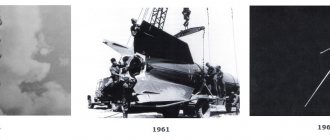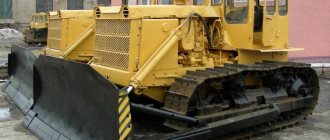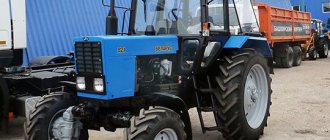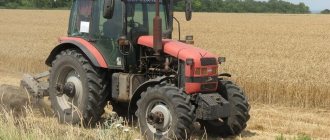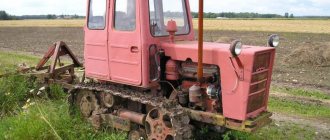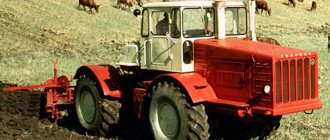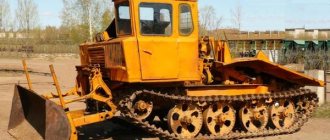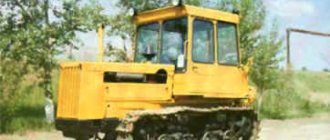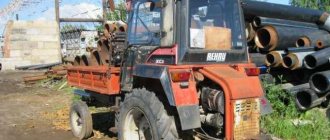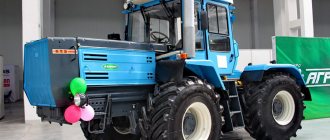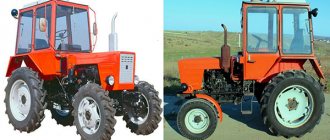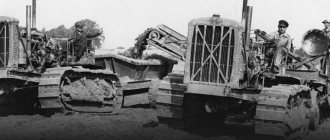Agricultural engineering
Definition 1
Agricultural engineering is a branch of mechanical engineering that provides equipment for agricultural production.
This industry originated in the 19th century in Great Britain and was further developed in the USA.
Agricultural engineering includes:
- Combine production – production of combine harvesters of various modifications
- Tractor manufacturing – production of tractors, engines and parts for them.
Note 1
Both directions began to actively develop in the 20th century, in many countries of the world. In the CIS countries, the leading position is occupied by Russian and Belarusian manufacturers, whose equipment is not inferior in quality to foreign brands.
Are you an expert in this subject area? We invite you to become the author of the Directory Working Conditions
The largest enterprises in Russia are rightfully considered OJSC Rostselmash (specializing in the production of grain and forage harvesters), OJSC Rosagrosnab (specializing in the production of spare parts and engines for various agricultural equipment), the Tractor Plants concern (includes four plants producing large equipment, the most famous "Agromash").
Products produced by the agricultural sector:
- Combines. This type of equipment is divided into grain harvesters (one of the most complex, designed for pre-processing grain crops), forage harvesters (designed for mowing grass and crops used to feed livestock) combines, as well as combines for harvesting root crops and vegetables. Combine harvesters are also divided into self-propelled and trailed, the latter being attached to tractors.
- Tractors. Self-propelled vehicles designed primarily to pull other vehicles. Tractors can be wheeled or tracked. Tractors with increased design requirements are now being produced. Tractors can be divided into row-crop tractors (for fields after tillage), arable tractors (for continuous plowing), transport tractors (for transporting goods with a trailer)
- Agricultural implements. This equipment is intended for intermediate agricultural work. The units are divided into: tillage machines (cultivators, subsoilers, harrows), seeders (for sowing seeds of all types of crops)
Finished works on a similar topic
Course work Agricultural engineering 450 ₽ Abstract Agricultural engineering 250 ₽ Test work Agricultural engineering 200 ₽
Receive completed work or specialist advice on your educational project Find out the cost
Tractor factories of the USSR
The main part of the machine-building industries that produce tractors are a legacy of the Soviet machine-building complex. Today, some enterprises are actively developing, having modernized their production facilities and expanded the range of manufactured machines. Some tractor factories have ceased to exist, but previously produced machines are still in active use.
MTZ
Tractors from the Minsk Plant are known on the agricultural machinery market under the Belarus brand. The production was founded in 1946 and is actively developing to this day. Today MTZ is the largest manufacturer of tractors in the post-Soviet space and is one of the 8 largest manufacturers of agricultural machinery in the world. The production association has a holding structure, which includes more than 12 machine-building enterprises.
Model MTZ-5
The model range of manufactured equipment covers all segments used in the agricultural sector, traction classes - from the smallest 0.2 t.p. to heavy-duty ones at 6 t.p. The bulk of MTZ tractor models, according to the classification, are universal, which allows the machine chassis to be used not only in agriculture, but also in other fields of activity using special equipment. Thus, based on a number of popular chassis of the MTZ 82, MTZ 92, MTZ 952 tractors, various types of excavators and loaders are produced. One of the popular Belarus tractor models, MTZ 82, has been produced by the plant, in improved modifications, for more than 48 years and is still in demand on the market, which indicates the high reliability and functionality of Belarusian equipment.
Energy-rich Belarus MTZ-4522
In 2022, the plant put into serial production the most powerful tractor in the MTZ model range, the Belarus 4522 6th traction cash register. The machine is designed for work as part of wide-cut tillage units with echelon arrangement of working bodies.
KhTZ
The Kharkov Tractor Plant (named after Sergo Ordzhonikidze) was founded in 1930. Until 1970, the company occupied a leading position in the production of tractors in the USSR. After the collapse of the union, the plant underwent a number of economic reorganizations and in 2022 went into rehabilitation status, as a result of the resulting public debt of 401 million hryvnia.
Wheeled T-150K
During active production, KhTZ produced a number of popular brands of tractors such as: Wheeled universal tractor T-25 (1969), crawler tractor T-74 (1974), crawler tractor T-150 and wheeled universal tractor T-150K (1970 G.).
Crawler T-150
During the period of independent Ukraine, the following models of equipment were produced: KhTZ-180, wheeled plowing tractor KhTZ-16131, farm machine KhTZ 3510, tractor KhTZ 181, wheeled general purpose tractor KhTZ-17212 (17222) (2006), road- construction bulldozer TS-10 (2007), low-power tractor for farmers KhTZ-2410 (2013) Tracked and wheeled tractors of the brand KhTZ-280T and KhTZ-240K, KhTZ-241K (2014-2015).
YuMZ
The production of tractors at the Southern Machine-Building Plant, in the city of Dnepropetrovsk, began in 1958, where, simultaneously with the Minsk Plant, universal row-crop machines of the MTZ-5 brand were produced. Subsequently, this model became the basis for the development and production of the wheeled universal row-crop tractor YuMZ-6, which was produced in various modifications from 1970 to 2001. The tractor was widely used both in agriculture and other sectors of the national economy of the USSR.
YuMZ-6AM
Since 2000, the Southern Machine Building Plant has been in economic and economic decline. From 2000 to the present, the company has made several attempts in tractor manufacturing with limited production of batches of universal tractors. The design of the new models used an identical base and transmission YuMZ-6 with imported hydraulic components and a power unit.
LTZ
Lipetsk tractor production was founded in 1943 on the basis of a machine tool enterprise. The dawn of the plant occurred in the Soviet period from 1960 to 1988. One of the most mass-produced machines was the wheeled universal row-crop tractor T-40 in the 0.9 t.p. class. The machine has gained its popularity for its versatility in use due to its relatively small dimensions, wide ability to work with drive equipment, and an unpretentious air-cooled power unit. Subsequently, this model provided the basis for the production of improved models of tractors T-50, LTZ-155, LTZ-55, LTZ-60, which are produced to this day.
Lipetsk tractor T-40
Lipetsk tractor LTZ-155
In 2004, the plant survived bankruptcy proceedings and was reorganized into the production of JSC Lipetsk Tractor, part of the concern of Russian machine-building enterprises Tractor Plants.
ChTZ
The Chelyabinsk plant is a leader in the production of heavy-duty tracked tractors for industrial use in the USSR. The first cars, under the brand name S-60 (Stalinets 60), left the enterprise’s assembly line in 1933. This model was a prototype of the American Caterpillar tractor.
During the Great Patriotic War, the Chelyabinsk plant produced artillery tractors, T-34 and IS-1 tanks, and self-propelled artillery mounts. During the war period, the design potential of the enterprise developed and put into production 13 types of tanks and self-propelled guns, and developed 6 models of tank diesel engines.
After the war, the company produced a number of models of high-power industrial crawler tractors, which were used in the development of mineral resources, in the construction of gas and oil communications, and in the development of the northern regions of the country.
The most powerful bulldozer ChTZ T-800
DET-250 tracked diesel-electric tractor T-100M (1963) the most widely produced model with a power of 108 hp. T-130 (1970) T-800 (1983) a tractor with a traction force of 75 t.p. was produced by state order. (the most powerful in the world at that time). T-130M (1984) T-170 (1988) DET-250M (1989) T-10 (1990) DET -320 (2002)
Today the plant has been reorganized into the enterprise OJSC Chelyabinsk Tractor Plant - Uraltrak. The company employs more than 6,000 qualified employees. The main products of the plant are the T-10M, DET-250M tractors and special machines based on them, the B-10M bulldozer, pipe layers, diesel power units with power from 12 to 1200 hp, diesel generators with a power of 100 kW, diesel-hydraulic installations for collecting oil pollution from the surface of water, low-power tractor "Uralets" with a power of 12 hp, spare parts for tractors.
CZPT
The Cheboksary Industrial Tractor Plant was founded in 1972 for the production of heavy-duty industrial machines. The purpose of establishing the production was to expand production capacity due to the lack of production of industrial tractors by the Chelyabinsk Plant. Specifically, the enterprise implemented the production of new Soviet models of tracked industrial models of tracked vehicles T-330 (1975) and T-500 (1985). Pipe layers for the installation of large-diameter pipes were also produced on the basis of these machines.
Cheboksary bulldozer T-330
As of 2022, the company is in bankruptcy and the production of tractors has been suspended.
HTA
The Onega Tractor Plant (Petrozavodsk) was launched in 1956 on the basis of the Onega Machine-Building and Foundry and Metallurgical Enterprises. The company specializes in the production of tracked vehicles under the Onezhets brand for logging work. Among the popular models of tractors and the most widely produced by the plant during the Soviet period, the following machines can be noted: diesel tractor skidders TDT-40 and TDT-55.
Skidder Onezhets
Later, all tractor models produced by the company were segmented according to their specialization in logging work. A number of models included: brush cutting machines, swamp vehicles, mulchers, skidders, log carriers, forest fire engines.
Today, the model range of machines produced by the plant includes: Onezhets 320 - choker skidding, Onezhets 310 - forest fire engine, Onezhets 390 - mulcher, Onezhets 350 - log carrier, tractors for chokerless forest skidding - Onezhets 333 (334, 335, 380, 382, 385 , 392, 395).
Currently, the Onega Plant, after bankruptcy, was purchased by the Belarusian machine-building holding Amkodor and renamed the company Amkodor Onego LLC.
Kirovsky Zavod
The origins of the creation of the plant originate from the Putilov Artillery Plant, which after the 1917 revolution was reorganized by the Soviet authorities into the Krasny Putilovets enterprise, where the first Soviet model of the Fordson-Putilovets tractor was produced in 1924.
During the Great Patriotic War, some of the plant’s specialists were evacuated to Chelyabinsk, where they carried out their work at ChTZ. The workers who remained in besieged Leningrad continued to assemble heavy KV tanks and repair military equipment at the facilities of the destroyed plant.
After the war, the plant remained a machine-building base for Soviet tank production, where in 1976 the first tank with a gas turbine engine, the T-80, was produced.
In 1964, the production of a model line of powerful energy-rich wheeled agricultural tractors of 5-6 traction classes under the Kirovets brand of the K-700, K-701, K-702 brands began.
Kirovets K-700
Since 2000, the plant has produced a number of the following models of powerful wheeled tractors: K-744 1995, K-744R 2000, K-708 2009, Kirovets-Powerplus 2011, K-9000 2012.
Today, Kirov Plant equipment is exported to near and far abroad countries: Kazakhstan, the Czech Republic, Germany, France, Canada, the USA, and Australia.
VMTZ
Vladimir Motor and Tractor Plant was founded in 1945. The first tractors produced by the enterprise were the T-28 machines, developed by the designers of the Kirov plant in Leningrad. The most famous tractor produced by the plant was the small-sized tractor T-25 (T-25A) under the Vladimirets brand.
In parallel with the production of tractors, the production of tractor diesel engines was carried out at the enterprise's facilities: D-37M, D-37E, D-21, D-144, D-145T.
Today, the company has been bought out after a complete stop of production and bankruptcy.
VgTZ
Volgograd Tractor Plant, which until 1961 was called the Stalin Tractor Plant named after F.E. Dzerzhinsky. The construction of the plant began during the Soviet period in 1926, as part of the large-scale industrialization of the Soviet state, and the first tractor rolled off the lines of the enterprise in 1930. At that time, the enterprise was considered a giant plant, the lines of which produced up to 210 cars in seven hours of work.
Crawler tractor of the Volgograd plant DT-75
The main well-known brands of tractors were tracked vehicles for general and agricultural purposes DT 54, DT-75, VT-100. After 2002, divided into parts, the enterprise fell into decline and was declared bankrupt by the court in 2005.
Crawler TV-100
Today, part of the production capacity of the former plant is given to the state corporation Rostec, where defense orders for the production of armored vehicles for airborne troops are carried out.
BTZ
Bryansk Tractor Plant is one of the youngest Russian tractor enterprises, founded in 2022. The plant produces a range of wheeled tractors with articulated frames and tracked vehicles for soil cultivation in agriculture. In fact, the tractors are modern analogues of the Kharkov plant T-150K, T-150 tractors, which became especially in demand after the collapse of the Union and the breakdown of economic cooperation between Ukraine and Russia. The model range of tractors produced by the enterprise is represented by the following brands of machines: wheeled - BTZ-243K, BTZ-244K, BTZ-245K, BTZ-246K, tracked BTZ-181 and BTZ-150.
ATZ
The Altai Tractor Plant, in the city of Rubtsovsk, Altai Territory, was founded in 1942 as a result of the evacuation of production facilities from the Kharkov Tractor Plant, the Odessa Agricultural Engineering Plant, and the Stalingrad Tractor Plant. The first tractors left the plant line in 1943.
At the enterprise's facilities, the country's first bulldozers DT-54 were designed and produced, which later became the basis for the production of the most widely produced crawler tractor DT-75. In 1956, the plant produced the diesel skidding tractor TDT-55, and in 1957 its improved version TDT-60 (with a forced engine). In 1962, the TDT-75 tractor and the TST-80 tracked vehicle for off-road cargo transportation came out of the company's lines. Since 1965, the plant began producing the T-4 tracked agricultural tractor, which later became the hallmark of the enterprise. An improved modification of this T-4A vehicle was produced from 1970 to 1998. Since 2007, the plant entered the stage of economic decline and in 2011 was declared completely bankrupt.
Today, on the basis of the potential of the former ATZ, the production enterprise Altai Tractor Plant LLC has been created, which presented its new development of a crawler tractor in the third traction class with a bulldozer linkage “Altai-130”. The enterprise's capacity allows it to produce up to 500 units of equipment per year. In addition, a number of Barnaul specialized industries - the Progress Self-propelled Machine Plant and the Altai Tractor Plant - continued the production of skidding machines developed by ATZ.
KTZ
The Chisinau Tractor Plant was founded on the basis of the Avtodetal enterprise for the production of automobile parts in 1961. The first tractor produced at a Moldovan enterprise was the T-50V in 1962. Since 1975, the plant began producing the T-70S beet tracked tractor based on the Belarusian MTZ 80 tractor.
Beet tractor from the Chisinau plant T-70
In 1995, the plant was reorganized into JSC Tractor. Today the company has stopped producing equipment. The economic activity of the plant consists of renting out space, and most of the workshops are in disrepair.
TTZ
The Tashkent Tractor Plant was founded in 1942 and specialized in the production of cotton-growing equipment. From 1960 to 1970, the main tractor models were cotton versions of the T-28 and MTZ-50 tractors, assembled from assembly units of the Minsk and Vladimir Tractor Plants. Subsequently, the plant was engaged in the production of transport trailers for cotton farms and the assembly of MTZ-80, T-28X4M tractors.
Cotton modification MTZ-80X
At the moment, the enterprise has been reorganized by decree of the President of the Republic of Uzbekistan into the enterprise TQXTZ JSC with the profile of producing tractors and machines for cultivating and harvesting cotton.
OZTM
Omsk Transport Engineering Plant, due to the specialization of its production, closely collaborated with military defense orders for the production of military equipment, in particular tanks, flamethrower systems and supporting loading vehicles for them based on tank tracked chassis.
ZTM-60
In the production of tractors, the plant's power was used to produce wheeled tractors ZTM-60 (analogous to YuMZ-6AL), which were produced under license from the Southern Machine-Building Plant. The plant also launched the production of EO2621B2 excavators based on this tractor. Subsequently, the company's designers carried out more than 50 technical modifications to the manufactured tractor model, including: equipping the machine with a front drive axle, equipping it with a gas-diesel engine, and manufacturing export and tropical modifications.
KZSM
Kolomyia Agricultural Machinery Plant is a nationalized enterprise by the Soviet government in 1939. Until 1958, the plant specialized in the production of feed grinding equipment for livestock farming. The company began producing tractor equipment in 1957. The first self-propelled vehicles PG-0.5 were designed for grab loading. From 1964 to 1988, most of the produced grab loaders of the PG-0.5 ST model were intended for the sugar industry of Cuba.
Grab Carpathian
In 1982, the enterprise, in terms of production volume, took a leading position in the production of self-propelled grab loaders in the USSR. A number of popular car models include the following brands PEA-1.0, PEA-1A under the Karpatets brand. The technical basis for the production of these machines was the assembly units and parts of the YuMZ-6 tractor.
At the moment, the enterprise is in a stage of economic stagnation, and serial mass production of equipment is not carried out.
Agricultural Engineering Centers
The agricultural potential of Russia is very large, and agricultural engineering plays an important role in the development of the national economy and the economy of the country.
Agricultural engineering enterprises are located in various regions of the country. Their location is determined by the proximity of the raw material base, specialization and cooperation with other industries, consumer demand and product features.
Since the products produced are quite bulky and difficult to transport, enterprises are located in areas of appropriate agricultural specialization.
Thus, grain harvesting machines are produced in the North Caucasus and Siberia. And the production of tractors is concentrated in Volgograd, St. Petersburg, Lipetsk, etc.
Agricultural engineering and its place in the economy
Agriculture is very different from what it was just a couple of decades ago, and the level of mechanization has increased significantly. However, despite this, insufficient equipment of agricultural machinery is a problem for the development of this industry. Both in Soviet times and now, Russian agricultural engineering could only impress with its quantitative indicators, while the technological level left much to be desired, inferior to its Western counterparts.
After the upheavals of the 90s, farmers experienced an acute shortage of high-quality agricultural machinery, since factories could only offer outdated models. That is why farmers were forced to purchase equipment abroad.
Today, agricultural machinery enterprises produce only 10% of GDP. Farmers, due to economic reasons, either have to wait a long time not to update their fleet of agricultural machinery, or purchase imported equipment, which leads to low production load at Russian factories.
Despite this, experts are confident that the potential for the development of agricultural machinery in Russia is simply enormous.
Equipping the Russian agro-industrial complex with agricultural engineering products
Even in the “golden” Soviet years, the level of equipment of the agro-industrial complex with agricultural machinery was at an unsatisfactory level. Especially when compared with the agriculture of Western Europe and North America. At the same time, the technological lag also made itself felt, which manifested itself in the low efficiency of agricultural machines.
The collapse of the Soviet Union worsened an already far from optimal situation. During the first fifteen post-Soviet years, the domestic fleet of agricultural machinery decreased by more than 4 times. Farmers were in dire need of even tractors and combines, not to mention more highly specialized agricultural machinery products. Moreover, the reduction of the fleet on a nationwide scale continues to this day, although at a much lower rate than before.
According to Rosstat, in 2014, Russian agricultural enterprises owned 247 thousand tractors and 64 thousand grain harvesters. For comparison, in 2000 these figures were at the level of 746 thousand and 198 thousand, respectively. At the same time, the equipment itself, which farmers currently have, according to experts, is 2/3 physically worn out and 80-90% morally obsolete.
The use of worn-out and outdated agricultural machinery affects the profitability of agricultural enterprises. Old tractors and combines require more operating costs, and the level of crop losses due to them is higher than when using new equipment. Moreover, the level of development of agricultural engineering in the country is such that new domestic equipment does not perform much better than “used” imported ones.
The most obvious indicator of the level of provision of the domestic agro-industrial complex with agricultural machinery is the number of tractors per 1 thousand hectares of arable land. In this indicator, we lag very significantly behind other countries. For example, in Argentina there are on average 8 tractors per this area, in Canada - 16, in Germany - 64. For comparison, in Russia there are only 3 (!) tractors per 1000 hectares of crops. The situation is similar for combines.
The state of Russian agricultural machinery industry
Despite the reduction in the total number of tractors, experts note a good pace of renewal of the agricultural machinery fleet. Government programs for the development of the agrarian-industrial complex played an important role in this. Although the level of imports of agricultural machinery is high, there is an increase in the output of domestic products. But despite this, the main advantage is still low cost, and not at all their manufacturability.
The largest manufacturer of agricultural machinery in Russia is Rostselmash and the Tractor Plants concern. Their distinctive part is the use of a minimum of imported components.
In 2016, about 6.7 thousand tractors were produced, and only half of them were domestic, 52% were assembled from imported parts.
Tractor trends: what new products are presented by leading manufacturers
19.01.2018
Author: Sergey Kuznetsov
The role of machine labor in the agro-industrial complex has always been valued. A significant increase in the production of agricultural machinery occurred during Soviet times, and not only in the USSR itself. But in the 21st century, volumes have dropped significantly. But the loss in quantity affected the quality. Over time, the capabilities of manufacturers have changed, and along with them, the requirements for equipment from farmers. Today, the agricultural machinery market is again being driven forward by leading manufacturers, who surprise us with new concepts every year. What can modern machines do in the agro-industrial complex and what trends are relevant in the production of tractors?
Small, but remote
In Russia in recent years, there has been a tendency for the demand for large agricultural machinery to fall. On the one hand, this is due to the growing number of small farms that neither need nor can afford such machines. On the other hand, in general the price level for large powerful tractors is now quite high.
Against the backdrop of a general decline in demand for agricultural machinery, the growth in popularity of mini-tractors is especially noticeable. At the end of 2016, their sales increased by 10.4%, and their share in the agricultural machinery market increased from 9.6% to 13.7%.
Their most obvious advantage is their much smaller size while maintaining all the basic functions of “large” tractors. Such machines are useful in small farms, since they are convenient to use on plots of up to 10 hectares. However, they often turn out to be necessary even at the dacha or in the garden. The functions of mini-tractors are very extensive: lawn care, soil fertilization, garbage collection (and also snow in winter), plowing, harrowing, aeration - this is already an impressive list. Efficiency due to low power should also be considered an undoubted advantage. Basically for this category it is within 20 hp.
In the mini-tractor market today, the tone is primarily set by American manufacturers (Magnatrac, TYM). Recently, however, Chinese companies (Xingtai, Jimno) have come closer to them in terms of build quality, but in Europe they are still lagging behind.
In Russia, one of the market leaders in this segment is the Chelyabinsk enterprise Traktor LLC, located in the city of Yemanzhelinsk. The plant produces several models under the Uralets brand with a capacity from 16 to 22 hp. With. The company produces about 1,500 thousand tractors per year, and the most popular model is the Uralets-220.
The second popular Russian brand of mini-tractors is Chuvashpiller. There are many more models in the line of this manufacturer from 12 to 35 liters. With. for any pocket and task. This enterprise also produces approximately 1,500 thousand tractors per year, and the model range is a copy of Chinese tractors, maximally localized for Russian conditions.
However, we can only talk about serious competition in the future. Nevertheless, the potential of domestic models, according to experts, is quite high. In addition, they are even more versatile than their foreign counterparts, plus they are maximally adapted to Russian operating conditions.
What technologies are in price today?
In addition to the introduction of new tractors and combines, leading manufacturers are constantly competing in the battle of technology. At the same time, specialized exhibitions have been and remain the main way to present their developments to the world. For manufacturers, this is an excellent opportunity to show off the latest achievements, and for others - to find out how far the industry has progressed.
In this sense, John Deere stands apart, having presented perhaps the most innovative solutions over the course of the year. For example, the company has developed a system that analyzes applied fertilizers and assesses the need for each individual area for additional fertilizing. This solution will not only save on fertilizers, but also generally increase the efficiency of crop production.
Another new product of the company in the same area is a system that determines the amount of chemicals used for comprehensive crop protection. Automation controls that the “chemistry” is not inadvertently overdone.
In addition, John Deere has come up with a very useful thing that can help when working on sticky soil - a system for automatically engaging all-wheel drive on the tractor. It engages all-wheel drive when the wheels slip and disengages it when the wheels are on a fairly level and hard surface. Experts have already rated the new product higher than its analogues and noted that it will reduce wear on tractor parts and increase productivity.
Many words of praise from experts went to another automatic development that can remember the repeated actions of the tractor driver. Such a system will be useful in limited areas where tractor drivers are often forced to do the same actions, including moving along the same trajectory, for example, turning around. The principle of operation is simple - when a sequence of actions is repeated three times, the system remembers it and will reproduce it in the future using just one button.
In general, technologies aimed at automation attract the most attention. A device that controls the distribution of ballast using hydraulics will significantly simplify the farmer’s work. This design will eliminate the need to put ballast on the rear wheels yourself during heavy operations.
Other mastodons of the tractor industry, although they were not particularly active in the development of new technologies, were not without surprises. For example, another flagship of AGCO's agricultural machinery production has received many positive reviews for its innovative system for quickly changing the pressure in tractor tires. It is based on an additional internal tire, which plays the role of a kind of “accumulator” and allows, depending on the situation, to change the pressure in the main tire within just 30 seconds. And what is important is that the engine speed does not drop, as usually happens in conventional tractors during tire inflation, which allows you to continue working without interruption.
AGCO engineers also came up with the idea of creating an innovative transmission system that can analyze and compare the load on the front and rear axles and, if necessary, level them. This design not only increases the efficiency of the transmission and the ease of operating the tractor, but also significantly reduces the impact of the equipment on the soil.
CLAAS Corporation has pleased us with its development in the field of optimizing tractor operation, the essence of which is the precise calculation of the route, analysis and forecast of the time it will take the tractor to complete the current task. The uniqueness of this technology is that it creates a diagram of the cultivated field and offers the optimal route for movement. This thing is very useful in cases where you have to work on large fields of irregular shape - the farmer ultimately saves both time and effort, and at the same time saves himself from unnecessary analytical thoughts and mental calculations.
Russian technology: a step forward
In 2022, domestic manufacturers seriously asserted themselves, and for the first time in a long time they were more than worthy competition for their Western colleagues. A new product from Rostselmash deserves special attention – the all-terrain tractor VERSATILE DeltaTrack 550. One of its most noticeable advantages is the ability to choose the desired track width. There are two options - 30 and 36 inches. The wheels are made of polyurethane, which is a much more durable alternative compared to conventional rubber counterparts. The main feature of the tractor lies in the design of the support roller frame. It has two degrees of freedom, which allows you to achieve several positive aspects at once. This includes less impact on the soil with better ride comfort (especially noticeable on uneven terrain), and a reduced slip rate, and at the same time a reduction in fuel consumption. In addition, the DeltaTrack line is equipped with an automatic transmission that includes 16 forward and 4 reverse gears. Such a large range makes the machine versatile and ready for long-term loads over large areas. The tractor driver's workplace is also adapted for this purpose. Not only has the cabin become very spacious (internal area - 5 sq.m.), it has also significantly improved ergonomics. All main functions are controlled by pressing one or two buttons located under the armrest. In short, there is a lot of space, but everything is at hand.
The St. Petersburg Tractor Plant also pleased us with a bright new product that can compete in the world market. The company began producing the modernized Kirovets K-744R4 tractor with a Mercedes-Benz turbodiesel engine producing 428 hp. and an updated cab with panoramic windows for improved visibility in the field.
By the way, both Rostselmash and the St. Petersburg Tractor Plant have made very significant progress in expanding their sales market over the past year. Both manufacturers regularly participate in world-class exhibitions and right there sign new agreements on the supply of their equipment to European companies. Moreover, even many foreign experts in the field of tractor construction openly say that a new stage in the development of agricultural machinery is beginning in Russia.
Where to go next?
When it comes to priorities for new developments, leading manufacturers are trying to cover as many options for potential improvements as possible. Mainly, this is, of course, the desire to maximize automation of work and reduce the influence of the human factor, including the introduction of computer control of various processes. They are also trying to improve ergonomics and increase driver comfort in every possible way. Of course, the technical characteristics of new products are not ignored, modernizing engines, transmissions, expanding the capabilities of the wheelbase, etc.
Sometimes companies implement ideas in aspects in which they do not specialize in principle. A worthy example is the British company JCB. It is best known as a manufacturer of backhoe loaders, but recently introduced a new range of fast tractors, the Fastrac 8000. Thanks to a powerful engine and continuously variable transmission, they reach speeds of up to 70 km/h, which can make a big difference when covering large areas.
It is also important to pay attention to details, which, at first glance, are not so significant. So, for example, the Zetor Major HS company, when developing the new HS model, among other things, changed the angle of rotation of the wheels. Having managed to increase it to the maximum possible (without compromising the other components) parameters, it was possible to reduce the turning radius to 3.9 m, which is quite small for a tractor, and can be a very significant help in the process of work.
But AGCO, when improving its most powerful (in the literal sense of the word) Valtra S line, paid attention to the convenience of steering, for which it added a Twin-Trac reverse drive to the package, and also focused on environmental friendliness by introducing e3 SCR exhaust gas cleaning technology. In addition, engineers have created comfortable acoustic conditions for the driver - the sound in the cabin does not exceed 71 dB. Another new product from the same manufacturer, the Fendt 1000 Vario combines class-leading traction characteristics with excellent maneuverability on almost any surface. Thus, unique solutions in different directions allow you to feel confident in the competition.
The beginning of the agricultural season - time for new products
The agricultural machinery market received its next batch of impressive and promising new products just a month ago. By the end of the year, world leaders in agricultural production traditionally present new products with an eye to the future. Some of them will begin to be sold in 2022, others will be further developed and improved. Thus, CLAAS showed the AXION 900 TERRA TRAC tractor - the first half-track tractor with full suspension. And the same AGCO presented the VarioDoc Pro accounting system, with the help of which several tractors connected to the Agrirouter platform will be able to exchange field log data. Their new product Fendt e100 Vario is also worthy of interest - the first battery-electric tractor that can work without recharging throughout the working day.
In general, in the developments of all leading manufacturers of agricultural machinery, there is a clear desire to combine two emphases - to focus on human needs and at the same time follow the spirit of the times, managing to respond to the emergence of new technologies in other areas, because ultimately everything is interconnected. And the fact that the process of cultivating the land has come such a long way from the plow and the simplest earth tools to sophisticated machines once again confirms that the agricultural sector has always been and remains a leading role in the life of mankind.
